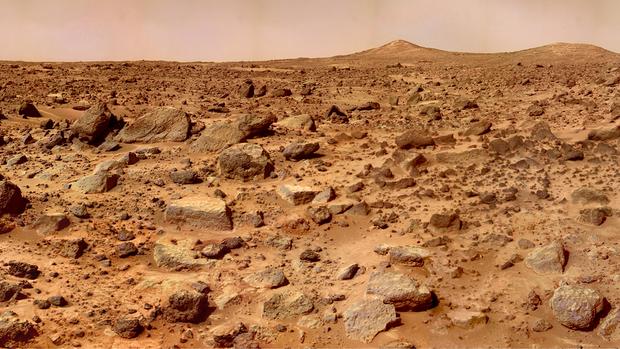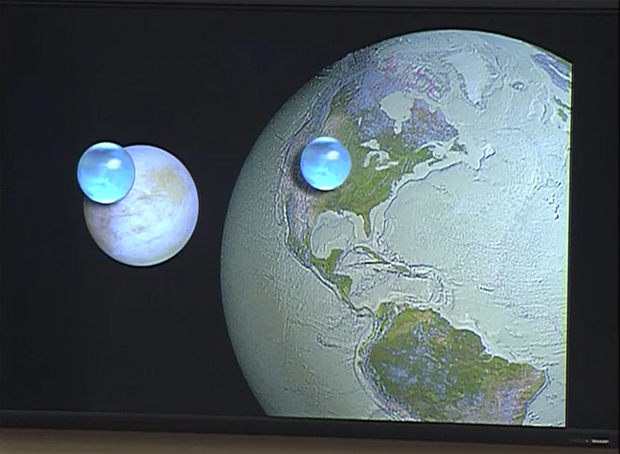Mars, Europa offer best chance to find ET, scientists say
The discovery of intermittent flows of liquid water on Mars, announced with great fanfare Monday, makes the red planet the leading candidate for the near-term discovery of extraterrestrial life in the form of fossilized microbes or even existing microorganisms, NASA's chief scientist told lawmakers Tuesday.
But Jupiter's moon Europa, with an icy crust covering an ocean with more water than all of Earth's seas combined, Saturn's smoggy moon Titan with its strange methane lakes and rivers and Enceladus, a moon of Saturn that spews icy particles into space from a subsurface sea that shows telltale signs of habitability, are equally, if not better, targets for long-term exploration.
"Make a list of the requirements for terrestrial-type life -- liquid water, organics, minerals, energy, chemical gradients -- and (NASA's Saturn orbiter) Cassini has found evidence for all of them in the plume of Enceladus," Jonathan Lunine, director of the Center for Radiophysics and Space Research at Cornell University, told the House Science, Space and Technology Committee.
But detecting clear evidence of extraterrestrial life in the solar system will not be easy, and Lunine cautioned not to expect the eventual discovery of entire organisms.
"Much more likely is that we will detect signatures that indicate that life is at work, or was at work, in these environments," he said. "At Mars, finding sources of methane and measuring their isotopes is one way to get at this question. Another is to seek well-preserved organic materials in the soil to see if they record the signatures of biology. And (NASA's) Mars 2020 rover will do the heavy lifting here."
As for Europa, NASA is in the preliminary stages of designing a spacecraft to orbit the Jovian moon to search for signs of organic compounds and water "welling up through the cracks on the surface and whether plumes exist and can be measured."
"Doing this mission, doing it now, is absolutely crucial to any general strategy for the search for life," Lunine said.
Looking beyond the solar system, Jacob Bean, an astronomer at the University of Chicago, and Andrew Siemion, director of the SETI Research Center at the University of California, Berkeley, said increasingly sensitive Earth- and space-based telescopes eventually will allow researchers to look for signs of biological activity in the atmospheres of extra-solar planets and, possibly, to detect signs of alien technologies.
But in the near term, Mars is clearly NASA's focus. Ellen Stofan, NASA's chief scientist, told the committee that the red planet is, in her view, the most likely place to find evidence of extraterrestrial life.
"I certainly believe it's going to be Mars," she said. "We're very optimistic about the 2020 rover and its potential for looking for signs for ancient microbial life. ... But again, I think it's going to take humans on the surface of Mars to really get at the definitive evidence to study that liquid water that we want to see."
On Monday, NASA unveiled clear evidence that briny water intermittently flows on Mars, remaining liquid at least briefly in warmer months due to the effects of perchlorate salts that effectively lower the freezing point.
Because life as it is known on Earth requires liquid water, along with energy from the sun and organic compounds already known to exist on Mars, the discovery of even intermittent flows of water on the red planet raises the possibility, at least, of sub-surface habitats that might be favorable to microbes of some sort.
"The exciting thing about knowing there's near surface water is saying maybe there could still be life forms on Mars today, deep underground, several meters below ground where the cosmic radiation that affects Mars would not affect them," Stofan said Tuesday.
Even though the water is relatively close to the surface and, in theory, accessible by robotic rovers, Stofan said astronauts and "a lot of work" will be necessary to resolve the issue. And that's assuming concerns about contamination by Earthly microbes can be resolved.
"It's one thing if you're looking for something large," she said. "If you're looking for something small, it's going to take time, and it's going to take effort. And that's why I think humans are so critical, and that's why NASA has chosen to be on this path and I think the findings from yesterday convince us we're on the correct path."
NASA's long-range plan calls for building a new super rocket called the Space Launch System to boost piloted Orion capsules, attached to a habitat module of some sort, to Mars in the mid 2030s, after flights in the 2020s to inspect and retrieve samples from a robotically captured asteroid fragment.
Between now and then, NASA plans to launch a lander known as InSight in 2016 to probe the interior structure of Mars and a Curiosity-type rover in 2020 that will look for signs of past and present habitability and evidence of ancient microbial life. The agency eventually hopes to launch a robotic sample return mission to bring a cache of martian rocks and soil back to Earth for laboratory analysis.
But Lunine said Europa was his first choice. And long overdue.
"The reason for that is we have so much tantalizing evidence that Europa is a habitable environment," he said. "But there are missing pieces, including whether there are organics and where to actually go search for life."
He said researchers have been waiting for a follow-up mission ever since NASA's Galileo spacecraft confirmed the presence of a sub-surface ocean in the late 1990s.
"From my point of view, it's a critical mission to do, and I would make that my number one right now," he said.
And what, exactly, will they be looking for? What constitutes "life" as it's known on Earth?
Lunine told the committee "life is a self-replicating system that undergoes evolution or mutation and which also seeks to minimize its local entropy, maximize its order, in the sense that chemically we use a very small fraction of the possible compounds that can be produced from carbon."
"And the fact that we're alive is because we can take in large amounts of nutrients, process them to make this very small, specific set of molecules that build our structure, control energy in and out, control the information needed to build these other molecules and then we expel the rest," he said. "So, for me with my physics background, it's very high order, very low entropy, in a chemical system."
Siemion provided a somewhat simpler definition, saying "life is something that we'll know when we see it."
"Hopefully that's true, but we're not sure," he said. "It's quite possible that the first life we encounter beyond the Earth will be very different than any kind of life that we have on Earth."
And what of the possibility of intelligent life in the universe?
Stofan said "maybe." Lunine, Bean and Siemion were more comfortable with "I don't know." But, Siemion added, "I think it would be incredibly strange if we are the only example of intelligent life in the universe."


